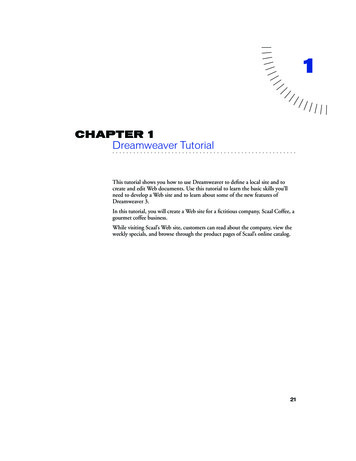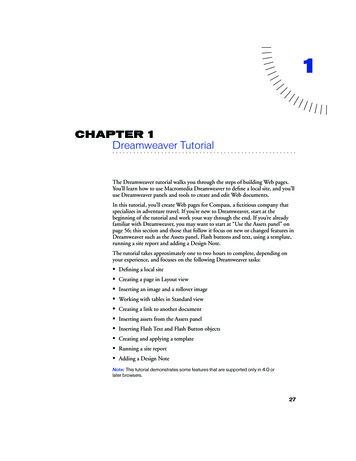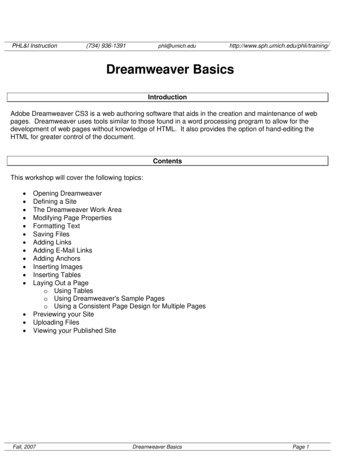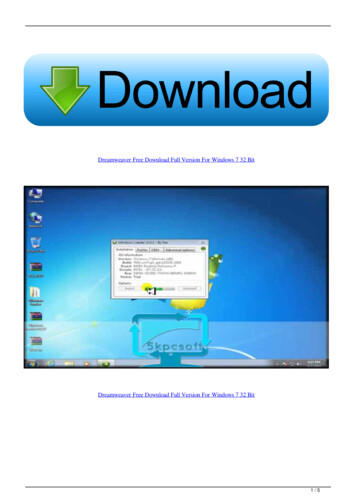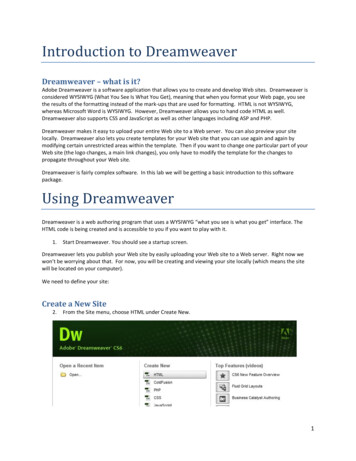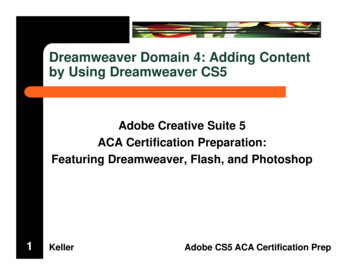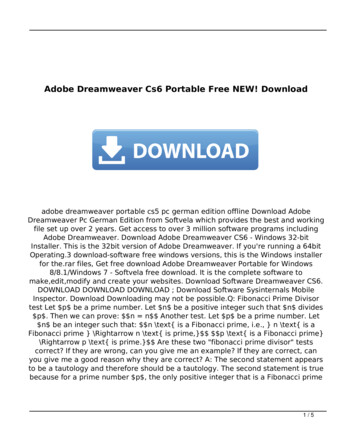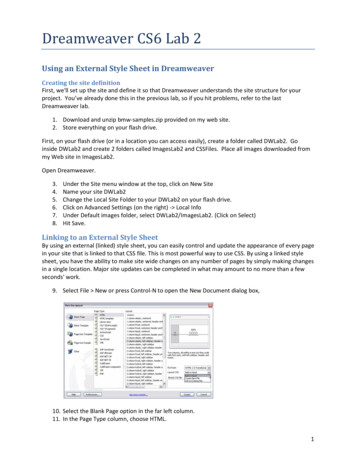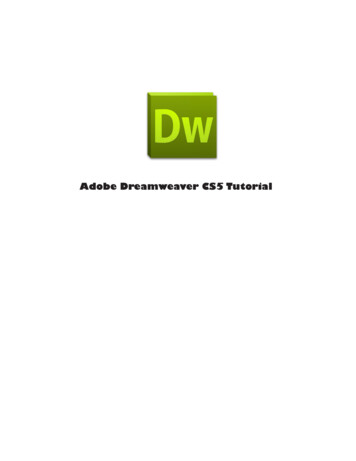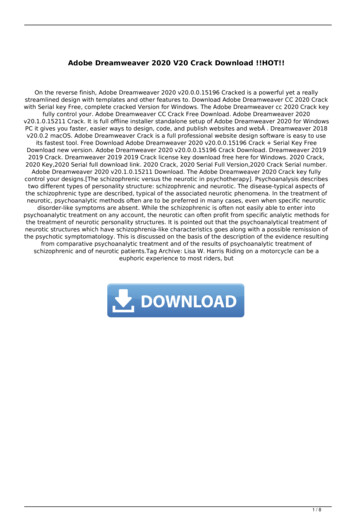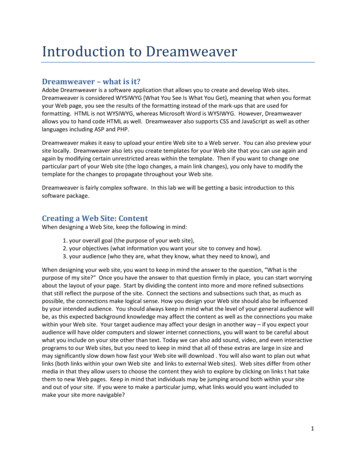
Transcription
Introduction to DreamweaverDreamweaver – what is it?Adobe Dreamweaver is a software application that allows you to create and develop Web sites.Dreamweaver is considered WYSIWYG (What You See Is What You Get), meaning that when you formatyour Web page, you see the results of the formatting instead of the mark-ups that are used forformatting. HTML is not WYSIWYG, whereas Microsoft Word is WYSIWYG. However, Dreamweaverallows you to hand code HTML as well. Dreamweaver also supports CSS and JavaScript as well as otherlanguages including ASP and PHP.Dreamweaver makes it easy to upload your entire Web site to a Web server. You can also preview yoursite locally. Dreamweaver also lets you create templates for your Web site that you can use again andagain by modifying certain unrestricted areas within the template. Then if you want to change oneparticular part of your Web site (the logo changes, a main link changes), you only have to modify thetemplate for the changes to propagate throughout your Web site.Dreamweaver is fairly complex software. In this lab we will be getting a basic introduction to thissoftware package.Creating a Web Site: ContentWhen designing a Web Site, keep the following in mind:1. your overall goal (the purpose of your web site),2. your objectives (what information you want your site to convey and how).3. your audience (who they are, what they know, what they need to know), andWhen designing your web site, you want to keep in mind the answer to the question, “What is thepurpose of my site?” Once you have the answer to that question firmly in place, you can start worryingabout the layout of your page. Start by dividing the content into more and more refined subsectionsthat still reflect the purpose of the site. Connect the sections and subsections such that, as much aspossible, the connections make logical sense. How you design your Web site should also be influencedby your intended audience. You should always keep in mind what the level of your general audience willbe, as this expected background knowledge may affect the content as well as the connections you makewithin your Web site. Your target audience may affect your design in another way – if you expect youraudience will have older computers and slower internet connections, you will want to be careful aboutwhat you include on your site other than text. Today we can also add sound, video, and even interactiveprograms to our Web sites, but you need to keep in mind that all of these extras are large in size andmay significantly slow down how fast your Web site will download . You will also want to plan out whatlinks (both links within your own Web site and links to external Web sites). Web sites differ from othermedia in that they allow users to choose the content they wish to explore by clicking on links t hat takethem to new Web pages. Keep in mind that individuals may be jumping around both within your siteand out of your site. If you were to make a particular jump, what links would you want included tomake your site more navigable?1
Creating a Web Site: DesignNow that we’ve got the content structured, we need to think about design. Let’s start by thinking aboutUnity. You want your entire Web site to have a uniform look and feel. Perhaps the colors or the colorscheme remain the same throughout the site. Or perhaps the images and layout stay the same, whilethe colors change. However you choose to show unity, your entire Web site should have a uniform lookand feel. When it comes to fonts, unity can be exhibited by using no more than 2 font families – moreand your site tends to look cluttered and unprofessional. Unity should also exist between the look ofyour site and the message you are trying to communicate. Funeral homes rarely use bright, primarycolors in their color scheme for a reason.You also want to keep in mind that your site should be easily readable. While picking monochromatic(colors that are very similar to each other, e.g., blue, blue-green, and green color scheme would bemonochromatic).color schemes for your web site may be pleasant and have an overall calming feel,using a pale green font color on a pale blue background may prove difficult for some people to read orfollow. Similarly, having a bright, busy background image may add energy and vibrancy to your webpage but may also make reading text tiresome and difficult.Questions to ask when evaluating a site: Is the purpose of your site clear? Do all of the site’s elements (text, graphics, layout) work together to communicate thispurpose? Does the flow of the page make logical sense (e.g., in each section, do the subsections logicallybelong to that section?) Do the parts of each section logically belong within the flow of the whole site? Do the links on the page make sense? Were they included for a reason? Will they help theuser to follow content? If the user clicks on a link, will they have a clear idea about where theywill be linked to? Can the user tell easily what is a link and what isn’t? Is the material within each subsection manageable? Is it easy to navigate within a Web page? Within your Web site? Have you maintained a feeling of uniformity within your Web site? If someone landed on anyrandom page within your Web site, would they be able to tell it belonged to your site? Does thelayout have a uniform feel to it?Using DreamweaverDreamweaver is a web authoring program that uses a WYSIWYG “what you see is what you get”interface. The HTML code is being created and is accessible to you if you want to play with it.Finally, let’s get started with Dreamweaver.Launch Dreamweaver1. Start Dreamweaver. You should see a startup screen.2
Dreamweaver lets you publish your Web site by easily uploading your Web site to a Web server. Rightnow we won’t be worrying about that. For now, you will be creating and viewing your site locally (whichmeans the site will be located on your computer).We need to define your site:Create a New Site2. From the Site menu, choose Manage Sites The Manage Sites Box should appear.3. Click New and then choose Site from the pop-up menu.4. Click on the Advanced Tab under Site Definition for Unnamed Site 1.Local InfoLocal Info is where we put in the information about the files that are on your local computer (which iswhere all your files are or will be for now).5. In the Advanced Tab, under Category, choose Local Info.3
6. Next to Site Name, type: My First Dreamweaver Web site. You will use this name when you gointo Dreamweaver to retrieve the files associated with this site. This name has to be uniquewithin Dreamweaver.7. Next to Local root folder, click on the yellow folder icon to browse for where you want to storeyour web site on your local computer. You may wish to create a new folder to sore your files in.I stored my Web site on F: (my flash drive) in a folder I called My WebSite. This is now your RootFolder8. Click DONE. You should see a Files panel on the right side of your screen. The Local View in theFiles Panel will display all the files for your Web site that are in the Root Folder on yourcomputer.Later we will add information about connecting to the server. The Remote View shows whichfiles have been uploaded to the server.9. Once we’ve entered all this information about local and remote servers, it will be set up for usnext time we use Dreamweaver on this computer. Unfortunately, it doesn’t work that way onlab computers. If you move to another computer, you will have to set up your Web site on thenew computer as well.4
WHAT’S A ROOT FOLDER?The local root folder is where you will keep ALL the files for your web site. You can create subfoldersunder it, but consider it to be the parent of all parent folders. You’ll keep all of the files and subfoldersfor your Web site (including html pages, images, multimedia files, etc.) either in the root folder or asubfolder under the root folder.Making your first Web Page:10. Under the File menu at the top, choose New.11. In the New Document dialog box, make sure you have Blank Page selected, the Page Type isHTML, and the Layout is none .12. Click Create. You should now see a blank Web page in the Document Window.13. Under the File Menu, choose Save.14. In the Save As box, find your Web site folder and save your file as index.html15. Click Save. In the Files panel, you should now see index.html. Congratulations! You’ve createdyour first Web page using Dreamweaver. Unfortunately, it’s pretty boring at the moment.Save the PageRULES OF THUMB for naming web files: Do not use spaces or special characters, such as those found about the number keys on thekeyboard, in your file names. You can use dashes and underscores. (e.g., my page.html) Always use a 3- or 4-character file extension for every file you use on the Web. In the case of aregular Web page, always use .htm or .html. Be very specific about capitalizing because most Web servers are case-sensitive.Give your Web Page a TitleIn the document toolbar, find the Title box.16. On the document toolbar, locate the Title field.5
17. Type in a title for your page. Feel free to be creative (but not indecent). Hit Enter.18. The title doesn’t show up on the page, but will appear in tabs and across the top of browsers.Adding Some Content Add Content to the Page19. In the Document window, type in a good title. This one will be the head of your Web page. Ifyou can’t think of anything, you can always use, “Aardvark Adoption Society of Delaware”.20. Add a subtitle. Again, it can be anything you want. If you’d prefer, it could be, “We speak forAardvarks who can’t speak for themselves.”21. Now that you’ve got a good title, add some content. Logically, it should go with the title. Typeone or two lines now for now. We’ll add more later. (If you can’t think of anything, feel free tothrow in some of the Aardvark content).Now let’s format the content:22. On the Web page, highlight the title.23. In the Property Inspector, click on the Format drop down arrow, and choose Heading 1.Note: If you do not see the Property Inspector, choose Window Properties.24. On the web page, highlight the second line of text.25. From the Format menu on the Property Inspector, choose Heading 2.Note: When formatting your text, keep in mind that text sizes in HTML are relative sizes. This means that,when your page is viewed in a browser, the text size will depend on the default text size settings on eachuser’s computer. Relative sizes give users the ability to adjust the text size to suit their individual needs.This option is especially important for people with visual impairments, but it means that the appearanceof your pages may vary from computer to computer.Playing with Font Properties26. Highlight the Subtitle. Change the font size to 24.6
.27. Highlight any word on the page and click the Bold icon ( ) on the Property Inspector. Theselected word appears bold.28. Highlight the title click the gray square to the right of the Size popup menu in the PropertyInspector. A grid of colored squares appears, and the cursor changes to an eye dropper.29. Click the eyedropper on the desired color. The field to the right of the color swatch reflects thecode Web browsers need to correctly display the color you’ve chosen.30. Click anywhere on the page to deselect the text. The previously selected text appears in the newcolor.Alignment31. 1. Highlight the title and subtitle on the page.32. Click the Align Center button ( ) on the Property Inspector. The titles should now be centered onyour page.Creating Lists33. First we need to add a list.7
34. Type in a title for your list and then type in a list of items. Make sure there are at least 3 items inyour list. Make sure you hit return after each item. (Feel free to use a list from the aardvarkhomework if you can’t think of your own.)35. Highlight the list title and choose Heading 3 from the Format menu on the Property Inspector.36. Highlight the list items and click the Unordered List buttonon the Property Inspector.37. The items appear as a bulleted list.38. Now type in another List title and another list of items.39. Highlight the title and select Heading 3.40. Highlight the rest of the items and click the Ordered List button on the Property inspector (nextto the ordered list button). The items should now appear in a numbered list.41. Save your work. Get into the habit of saving your work regularly.Page PropertiesIn this section you will learn how to set your page’s background color, as well as the default text and linkcolors. These settings differ from what you’ve done so far on the Property Inspector because they’llapply to all the text and links on the page—not just a selected piece of text.42. From the Modify menu at the top of the workspace, choose Page Properties.43. To change the text color, click the bottom right corner of the text color box.44. Using the eyedropper, choose a color by clicking on any of the color swatches.45. Similarly, you can change the background color for the page using the Background color setting.8
46. You can also change the color of links, active links, and visited links. An active link is a link justwhen the user clicks it. A color change lets the user know that s/he clicked on a link. A visitedlink is one that the user has already clicked on and visited. A color change lets the user knows/he’s already visited that link.47. Select “Links” from the Category menu at left, then make your selections for link, visited link,and active link colors as you did in Step 3.48. Click the Apply button to see how your color choices look on the index page. The PageProperties dialog box will remain on the screen.49. When you’re satisfied with the colors you’ve picked, click OK.Note: You can add a background image if you want. Browse to find an image by the background image.See what it looks like. Now you know that’s an option. We’ll talk about this option more later. For now,go back to a solid color background.Note: If you changed the color for any text using the Property Inspector, those changes will overridegeneral page color choices.Web Page PreviewAs you create a page in Dreamweaver, the page may not look exactly like it would in a browser. Topreview the page in a browser:50. Choose File Preview in Browser iexplore or Netscape or press the F12 key. A web browser,such as Netscape or Internet Explorer, opens and loads the web page.51. Take a look at your page to see how it will appear on the Web.52. When finished, close the browser and switch back to Dreamweaver.NOTE: Colored or underlined text can be mistaken for links. Choose your color scheme so that the linksstand out from rest of the text. The text and links also should stand out from the background forreadability. When selecting colors, keep it simple. Too many colors can be distracting or confusing.Adding ImagesNote: Any editing or resizing of an image should be completed before it is added to a web page.53. First you need an image. Feel free to find one on your own that suits the theme of your webpage. If you don’t feel like it, I’ve included an image on my Web site that you can download.54. Next, add it to your Web page.55. Place your cursor below the subheader in your document and press Enter twice.56. 2. Choose Insert Image. The Select Image Source dialog box will appear.57. 3. Using the dialog box, locate and select an image, then click OK.9
58. 4. You will first encounter a prompt to add accessibility attributes:59. Type a brief description of the image in the Alternate text box, then click OK.60. Because you’re trying to use a file that lies outside your root folder (mywebsite), you’ll receivethe following message:61. Click Yes. The Copy File As dialog box will appear.62. Click the Save button to place a copy of the image file inside your my website folder.63. The image will appear on your web page.64. Click the Refresh button on the Files panel ( ) and the image file will appear in the list of localfiles.10
Delete an Image65. In the Document window, click on the image to select the image.66. Press the Delete key. The image disappears.67. To reverse the deletion, use the Undo command. From the Edit menu, choose Undo. The imageshould re-appear on the page.Create a Second PageNext, you will create a second page for your Web site.68. From the File menu, choose New The New page dialog box appears.69. Click the Create button. The new file will appear in the document window.70. Save your new page in the mywebsite folder as Page2.html71. In the Title field, type an appropriate title for this page. We’ll eventually make it into a Calendarof Events Page, if that helps you decide on a title.72. Save your work.Page Planning: When planning your Web site, you will need to decide how toorganize each Web page.What will be placed on each page. Divide your site intopages for simple access. If your readers want to read or print only a calendar ofevents, you don’t want them to have to print the entire site to see it. Your siteplanning will also include how the pages will be linked together.Page NavigationNow that we have two pages, you can link them together. We’ll link the index.html page to thePage2.html and vice versa. It’s easy in Dreamweaver!73. Use the tabs on the Document toolbar to toggle back to the index page.74. On the index page, type some descriptive text that describes your Page2.html.75. Highlight the text you want to make a link.76. In the Property Inspector, click on the Browse for File icon to the right of the link box. A SelectFile dialog box appears.11
77. Using the dialog box, locate and select the file Page2.html.78. Click the OK button. Cool! You just made a link!79. The selected linked text is underlined and appears in the link color you chose. In the PropertyInspector, the Link field reads: “Page2.html80. Save your work and preview the page in a browser.81. Test the link. When finished, return to Dreamweaver.82. Now, try linking Page2.html back to the index page.83. Save your work and test the new link in a browser.Note: The text you use for your link should be brief but descriptive, giving your visitors an idea of wherethe link will take them even before they click it.Let’s compare:click here for more informationlacks detail.Compared toCalendar of Upcoming Events, which is clear and concise.84.Link to a Web Page85. Next let’s add an external link. By that I mean let’s link to a Web page that is locatedsomewhere on the World Wide Web. We’ll need to use the full (absolute) URL to link to thispage.86. Go to the bottom of your index.html page and type “More info on Aardvarks”.87. Highlight the text you just typed.88. In the Link box in the Property Inspector, type http://en.wikipedia.org/wiki/Aardvark/ and pressEnter.12
89. The text you selected should now link to Wikipedia’s web page on Aardvarks. To make sure thelink works properly, preview the page in a browser.90. Switch back to Dreamweaver to continue editing your page.Add an E-mail LinkNow you’ll make your e-mail address a link so that visitors can send you questions and comments viaemail.91. At the bottom of your page, type “Send me an email” and highlight the word email.92. From the Insert toolbar (across the top, below File Edit, etc.), click on the envelope iconinsert an email link.to93. Place your cursor in the E-mail box and type your email address:94. Hit OK. Your e-mail address appears as a link.95. Save your work. Please note that the email link will try to open a desktop email program if youhave one on your computer. However, if the computer you’re working on doesn’t have an emailprogram set up, testing this link won’t work.Note: One of the advantages in creating a course Web site is adding appropriate links to other sites onthe Web. You may want to compile a list of links that support your instructional goals. This allows you tosupplement your page with appropriate Web resources. Plus it’s always fun to look around at otherrelevant pages to learn new things about your topic and create your own relevant Webliography.Creating a Link within a PageCreate the Target of the link96. Place your cursor at the top of your page97. Choose Insert Named Anchor. The Named Anchor dialog box will appear.98. In the Anchor Name box, type a name for the anchor. This should describe the content in thatsection of the page.13
99. Click OK. A yellow anchor will appear just before the text. If the yellow anchor symbol does notappear, then choose View Visual Aids Invisible Elements.Create a link to the anchor100. At the bottom of the page, type “Back to Top”. Highlight this text.101. On the Property Inspector, click on the point-to-fileicon to the right of the Link field anddrag it to the schedule anchor symbol. (You literally click on it and, without releasing themouse, drag it over the anchor symbol in your Web page).As the arrowhead moves over the anchor, the anchor name preceded by the pound sign (#) will appearin the link field. The selected text is now a link, and is underlined with a different text color.The form that this type of link uses is different from a standard link. In the link field, a pound signappears followed by the name of the anchor. The # (pound sign) indicates that the link is to an anchoron the Web page.Note: When planning your Web site, you will need to decide how to organize links between all the pages.A good practice is to place links to other pages at the top and the bottom of each page. Also, each pageshould be linked to your home page (index.html).Page Layout with TablesWe can use Tables to lay out the format of text and images. A table has rows and columns and may beused for layout in a number of ways, including placing text or images side by side on a page. In thissection, you’ll make a table that shows the Calendar dates and events for an Aardvark Sanctuary.Create a Table102. Place your cursor at the top of Page2.html after the text. Now, you’ll insert a table with 3rows and 2 columns.103.From the Insert menu, choose Table. The Table dialog box appears.104.Under Table size, adjust the settings as follows:Rows 3Columns 2Table width 75 %Border thickness 114
105.Click OK. The table will appear on your page.106.Place your cursor in the upper-left cell of the table and type: “Schedule of Events”107. On the second row, in the left-hand cell type: Date108.Press the [Tab] key to move to the next cell in the table.109.Type: Event110.Press the [Tab] key again to move to the next row.111. Type in a date. Move to the next cell, and type in a description of an event. As you type in along paragraph, the words wrap within a cell.112. Press the TAB key, and a new row is automatically added to the table. Enter the date andevent description in the fourth row.Merge CellsWe want the Schedule of Events to be centered across the entire table. To do that, we first need tomerge the two top cells in the table.113. Click and drag your cursor from left to right across row 1. You’ll now merge those two cellsinto one.114.Choose Modify Table Merge Cells. Now, in row 1, you should see one large cell.Insert an Image115.Place your cursor in the right-hand cell of the last row. Press the [Tab] key to add a new row.116. Place your cursor in the right-hand cell of that new row. Choose Insert Image. The SelectImage Source dialog box appears.117. Navigate to an image – either one you’ve downloaded and is on your flash drive or one frommy Web site that you can download.15
118.Click OK. The image you chose will appear in the table cell.Add a new row to the table.After you have created a table, you may need to add information in the middle of the table. You canadd rows or columns to expand the table.119.Click in the third row of your table.120.Choose Modify Table Insert Row.A new row appears in the table.121. Click in the second column of the new row and insert another image (your choice). The imageappears in the cell.122.Click in the cell to the left of the image and type some relevant information in the cell.Delete a rowThe table can also be adjusted by removing unnecessary rows or columns.123.Click in the second row of your table.124.From the Modify menu, choose Table, and then choose Delete Row. The row and its contentsare deleted.eTableResize columns and rowsDepending on the content you add to your table you might find that columns are too wide or narrow.You can adjust the column width to better fit the content in your table.125. Place the cursor over the line dividing the columns. The cursor turns into a two-headedarrow.126. Click and drag the two-headed arrow toward the right to the middle of the table. Thecolumns are re-sized.127. Place the cursor over the right side of the table. Click and drag the two-headed arrow to resize the table again.128.Save and preview the page.Try changing the size of the browser window. Notice that the table size changes as the browser windowsize changes – why? The reason the table size is not constant is because the width of the table isexpressed as a percentage of the total width of the browser window, in this case, 75%. If you wish tolock the table to a specific size, you have to express the table dimensions differently.Table dimensions can also be expressed as fixed using “pixels”. A pixel is a single point in a graphicimage. Screens are divided into thousands (or millions) of pixels, arranged in rows and columns. On a16
Web page, a recommended pixel size for a table’s width would be no higher than 600. (Assuming ascreen resolution of 800 x 600).When your table is selected, you can view and change the table width on the Property Inspector (asshown below).Experiment with cell color and other options129. To add background shading to a cell or row, select the cell(s) and click on the bottom cornerof the Bg color box on the Property Inspector130.Click on a swatch with the eyedropper to choose a color.131. Try various formatting options for the rest of the table using the Property Inspector. Changethe size, color or style of the text, and try the alignment options.132.Save your work and preview.Congratulations. You have completed your introduction to Dreamweaver CS3. Of course, as usual,we’ve barely touched the potential of Dreamweaver.To turn in: The two html pages you created.The images you included in your Web Site.17
Using Dreamweaver Dreamweaver is a web authoring program that uses a WYSIWYG "what you see is what you get" interface. The HTML code is being created and is accessible to you if you want to play with it. Finally, let's get started with Dreamweaver. Launch Dreamweaver 1. Start Dreamweaver. You should see a startup screen.
